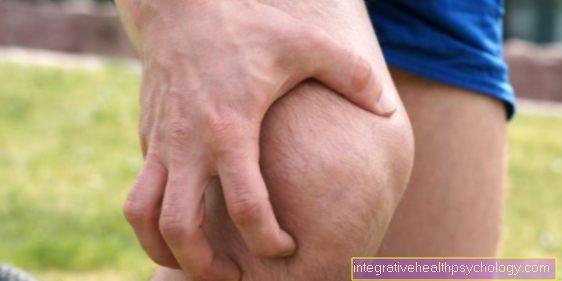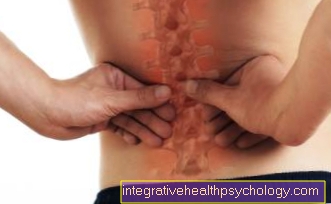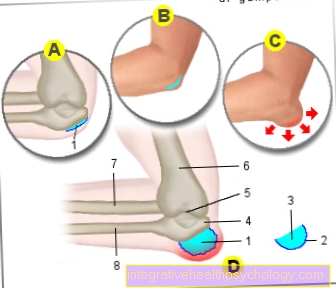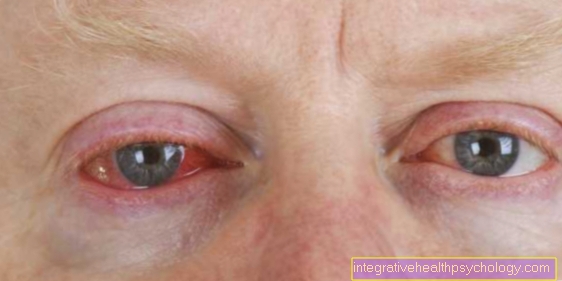Facelift
Synonyms: face lift; Latin rhytidectomy
General
The facelift describes a surgical method used to remove skin folds. The face lift belongs to the group of plastic-aesthetic operations and for this reason is not covered by statutory or private health insurance companies. During the facelift, the plastic surgeon tries to tighten the superficial skin of the face and the underlying tissue, and to give the slack areas new tension. The result of a successfully carried out facelift is a rejuvenation of the facial features of the patient being treated.

Performing the facelift
The procedure of a Facelifts is primarily based on the initial state, i.e. the Degree of relaxation the skin of the face, and the scope of the operation.
Basically, the plastic and aesthetic surgery between a complete face lift and the treatment of individual areas (for example: Forehead lift and Cheek lift). In order to achieve the smoothing of a certain area, both the skin and the muscle structures must be tightened and sutured by attaching sutures to solid structures.
After the actual facelift, the resulting Excess skin removed and the resulting skin edge sutured as inconspicuously as possible. In patients in whom the sagging of the skin has only progressed to a minor degree, the treating doctor may refer to a non-cutting treatment method fall back (so-called Thread lifting).
During the thread lifting will be Gold or plastic threads used to fix and tighten the skin tissue. However, this method is based on the problem that excess skin parts cannot be removed and the effectiveness is correspondingly limited for this reason.
What is a massage face lift?
There are different massage tricks for firm facial skin. In general: If you want to tighten your face with massages, the massages should be used regularly in order to achieve success. Facelifting massages are often offered in massage parlors, for example Thai facelifting massages or Indian methods that are intended to tighten the face.
The thinking lines on the forehead can be smoothed out by brushing gently with the fingertips from the middle of the forehead to the temples.
To firm the skin around the cheeks and mouth, massage begins in the area from the nose to the ears. Start at the wings of your nostrils and gently stroke your cheekbones. Form a V with your middle and index finger, place it above and below your lips and pull the movement up to your ears. To finally tighten the chin, knead the skin with your thumb and forefinger along the chin up to your ears. More pressure can certainly be applied to consolidate the contour.
If there is a frown line between the eyebrows, alternate strokes of the index finger in the direction of the eyebrow.
To lift the drooping eyelids, begin the massage with circular movements from the root of the nose under the eyes to the temples. Then you put the ring finger and the base of the eyebrows on and push them up slightly. The eye is closed and you massage your fingers along the brow. Move your finger up to your ears with light pressure.
Facelift through massage
The trend in anti-aging and face lifts is towards lasers. The facial wrinkles are removed in a single operation and the complexion is significantly improved.
With this facelift you should even achieve better results than with a surgical facelift. The laser treatment is gentle on the skin and due to the comparatively low stress on the skin, the downtimes for patients remain very short, 3 to 5 days.
As part of the laser treatment, heat is generated which simply evaporates the treated areas. So there is no direct ablation of the skin. Immediately after the treatment, the patient will notice an improvement in the sagging skin. In the days after the laser procedure, the skin continues to tighten as the laser uses IPL technology (Intense pulsed light) work.
This means that the high-energy light stimulates the formation of collagen in the skin, which has a firming effect afterwards. The result of a facelift with laser can improve even after 6 months.
Facelift with creams
Wrinkle creams are popular for smoothing out fine lines without surgery. There are people who already have their first wrinkles in their mid-twenties, others only when they are forty.
Most people sooner or later end up with an anti-wrinkle cream in the bathroom that is supposed to provide a natural face lift. Creams that promise a face lift usually have ingredients that bind moisture and optimize the water balance of the tissue. These include glycerine, algae extract, urea, lactic acid, panthenol and the popular hyaluronic acid.
Antioxidants are also found in numerous creams. Examples are vitamins A, C, E, coenzyme, Q, flavonoids and polyphenols, which are supposed to protect the skin from damage caused by so-called free radicals.
Ectoin is another substance that occurs naturally in bacteria and is supposed to protect the skin from harmful environmental influences and dehydration.
The right creams that match the individual skin type can help lead to a light facelift if used regularly, by providing the skin with sufficient moisture and making it look healthy. To get the maximum benefit from the effect of the creams, you should start using them as early as possible.
Facelift with tapes
There are facelift tapes that are supposed to tighten and firm the skin. There are different tapes such as different areas of the face that should be tightened.
Such a facelift tape is fixed on the face depending on the location. You can fix the straps behind the ears to tighten the middle part of the face, the eye area or the forehead.
There are different ways to use the tapes and precise instructions for the correct attachment of the facelift tapes. You can buy sets with several adhesive pads for 25 € and use them multiple times.
There are even see-through facelift tapes that you can put on make-up and wear on the street.
Facelift with stem cells
The stem cell facelift is a skin-tightening method that is carried out on an outpatient basis in a minimally invasive manner.
The doctor first takes stem cells from the patient's fat, processes them and injects a mixture of fat and stem cells under local anesthesia into the skin areas to be injected on the face.
You can combine the procedure with targeted liposuction or just remove the fat required for the facelift.
Surgical procedure
A facelift cannot be performed in the same way for every patient. There are different surgical procedures that have different advantages and disadvantages and for this reason appear more or less suitable for certain desired results and initial situations. The most popular facial tightening methods include the so-called SMAS lift, the mini lift and the liquid lift. The healing time following the facelift depends on the one hand on the scope of the operation, i.e. on the degree of smoothing of the skin and the degree of relaxation of the facial skin of the respective patient. On the other hand, the selected surgical method plays a decisive role. Less traumatic interventions require a shorter healing time, while healing after an invasive procedure takes much longer.
Find out more now: Scar care
Duration of the operation
The duration of a surgical facelift depends on the selected surgical method and the extent of the face lift. With a conventional facelift, the operation takes an average of three to four hours and takes place under general anesthesia.
SMAS lift
While performing an SMAS lift (Superficial Muscular Aponeurosis System-Lift) will pay special attention to one Muscle connective tissue layer, which in the subcutaneous tissue of the Face and neck area lies, laid. Although this muscle-connective tissue layer is very thin, it has an enormous one tensile strenght and Resilience on. Although the SMAS lift is comparatively traumatic for the facial tissue, it is the only one for many specialists in plastic and aesthetic surgery effective and long lasting Variant of skin tightening. Long-term observations clearly show one in comparison to the mini-lift longer shelf life of the surgical result. Even within this process, there are diverse procedures and types of cutting and sewing. In order to achieve the best possible result, the surgical procedure must be adapted from patient to patient. The average duration of surgery is between three and five hoursFollowing the face lift is at least one one day hospital stay necessary.
Mini lift
This method of facelift is mainly used on medium-height facial areas, especially on the Cheeks and at the lateral jaw section, carried out. Before the actual skin tightening, the attending surgeon makes an incision just in front of the auricle and extends it beyond the hairline and to the area of the temples. In contrast to the SMAS-Lift, this variant of the facelift only uses the skin, not the muscles under the skin tissue, tightened. The surgeon then removes it excess skin flaps and or Tissue proportions and closes the tissue with a Skin seam. In most cases, no visible scars remain. During the mini-lift, additional corrections to the eyelids (Eyelid lift) and / or the forehead (Forehead lift) be performed. The face lift is under most of the cases local anesthesia carried out, can also request but also under anesthesia respectively. The average duration of the operation is approximately one to two hours. In principle, it is advisable to stay in hospital for at least one day after the operation, but the mini-lift can also be used under certain circumstances outpatient be performed. The advantage of this method is the comparatively gentle handling of the tissue during the operation, but experts consider the mini-lift to be an ineffective type of facelift. The result is usually not long-lasting.
Liquid lift
The so-called Liquid lift represents and will be an alternative to a surgical face lift without cuts carried out. This method is particularly suitable for small Skin elasticity deficits, Volume losses and slight wrinkles. During use, a filling material is inserted between the areas of skin to be treated and the tissue underneath with the aid of a thin injection needle. So the wrinkles just become padded and with artificial volume filled up. It also increases the body's production Collagen stimulated and the complexion further improved. On average, the duration of treatment per session is between 10 and 20 minutes. The number of sessions required depends on the initial condition and the desired result of the respective patient. The durability of the treatment result varies from patient to patient, but is positively influenced by the stimulation of collagen formation.
Combination operations
In order to bring up a result that is ideal for the patient, a so-called Combination operation be necessary. As part of the actual facelift, an additional one is therefore often required Tightening of the upper and / or lower eyelids (lat. Blepharoplasty) performed. Furthermore, the facelift can be combined with a Liposuction of the neck and / or chemical peels be performed.
What are the consequences of a surgical facelift?
After a surgical facelift, a feeling of tension and swelling in the skin area are typical. After the operation, bruises will appear on the cheeks and under the chin.
Because of the tense skin, many patients describe a feeling of numbness in the face. The swelling reduces after two days and after about three weeks the bruises and swellings go away completely. The face tightening rarely causes damage to the nerves that supply the skin and muscles of the face. If this is the case, the damage is usually repaired by the body itself after weeks to months. Permanent nerve damage is very rare during a facelift.
After the facelift, it is important to take a week of rest and not take a shower. In addition, make-up should not be used.
The healing time varies after the operation and depends on the individual disposition and the extent of the intervention. The final result of the facelift can only be seen after a few months.
Outpatient follow-up care is necessary after the operation. If infections or scarring occur, this can be treated by a doctor. After the face lift, a professional, cosmetic follow-up treatment of the skin is recommended in order to promote the healing process. A targeted massage (Lymphatic drainage) helps to remove lymph congestion on the face.
In the first four weeks after the facelift, you should avoid cigarettes and blood-thinning medication (e.g. acetylsalicylic acid ASA) in order to avoid wound healing disorders and secondary bleeding.
Sunlight should also be avoided and, if this is not possible, sufficient sun protection should be applied.
Do you see scars after a facelift?
With a face lift, the skin and the underlying tissue are shortened and tightened. The scars usually end up hidden. The reason for this is that the cut runs in front of the ear or along the ear into the hairy temple region or into the hairline, depending on the excess skin to be removed. The cut runs downwards around the earlobe behind the ear, possibly up to the neck hair area, if the neck is also tightened. These cutting techniques are usually effective in avoiding visible scars and are not noticeable.
Risks
With a facelift, of course, there are the general risks that exist with any other surgical procedure. In addition, it can be especially in the face under certain circumstances Nerve damage come. Frequently occurring risks are the emergence of Swelling and Bruising in the operating area. Infections and Wound healing disorders can lead to serious complications, disruptions to the results of the operation (for example, unsightly Scarring) and / or one renewal of the Healing time to lead. Above all, a suitable, careful incision, maximum sterility and a tension-free approach of the wound edges can significantly reduce the risk of scarring and wound infection. In addition, special Scar ointments help prevent unsightly scar tissue from forming. A surgical result that is as symmetrical as possible is essential for a harmonious overall impression. Asymmetriesthat arise in the course of a facelift can seriously disrupt the entire facial image. However, asymmetries can often arise, especially in the face area. This risk can only be minimized through careful implementation and a wealth of experience on the part of the treating surgeon.
The possibility of violating the Facial nerve (Facial nerve) poses one of the greatest risks in facial surgery. This nerve supplies the whole Facial muscles and is therefore for the facial expressions essential. Since the facial nerve has an enormous number of branches and cross-links, damage and irritation of small nerve branches can be compensated in many cases. If this is not possible, then arise Paralysis of the affected facial muscles and restrictions in facial expressions. Affected patients show strong distortions, especially when they laugh. This Failure symptoms usually do not persist permanently, within the first six months there is a significant improvement in a large number of patients Muscle paralysis, in most cases the damage is even completely reduced. In addition, there is also the risk of damaging or severing branches of the during the facelift sensitive facial nerve (Trigeminal nerve), The consequence is a restricted one Feeling perception in the affected skin area.
costs
A facelift belongs to the purely plastic-aesthetic operations and for this reason is not covered by statutory or private health insurances. The prices within Germany fluctuate greatly and ultimately depend on the initial condition, the patient's desired result, the selected surgical method and the type of sedation. In most cases the cost will be in the range of 4,000 - 9,000 euros, included general anesthetic.
The main part of the costs does not make up for the actual facelift, but above all the general anesthesia, the post-operative monitoring and the subsequent hospital stay.
As a rule, the necessary preliminary examinations, the consultation and all necessary control examinations are covered by these costs. Performing a facelift abroad is usually much cheaper than a face lift in Germany.
The argument: Plastic operations abroad are much more risky and less well performed than in Germany, is largely unsustainable. Since the training standards in other European countries largely correspond to those in Germany, there is nothing wrong with an operation within Europe. Carrying out a facelift in a non-European country does not necessarily have to be of poor quality. It is generally a good idea to seek several opinions and suggestions before choosing the right plastic surgeon.












.jpg)
















